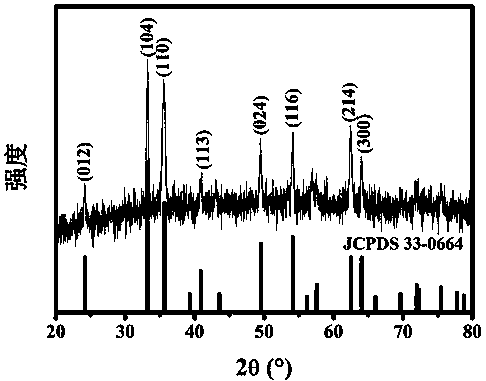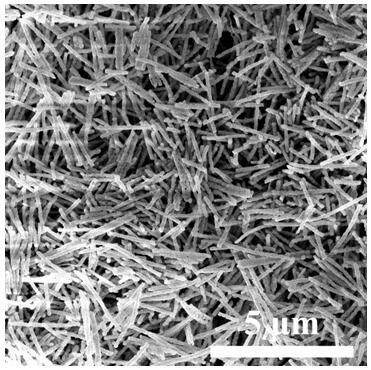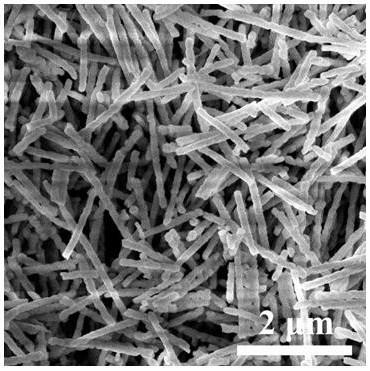an α-fe 2 o 3 Electrospinning synthesis method of rod-like structure
A technology of electrospinning and synthesis method, which is applied in the field of electrospinning synthesis of α-Fe2O3 rod structure, which can solve the problems of time-consuming, low efficiency, and complicated microwave process, and achieve good technological innovation effects
- Summary
- Abstract
- Description
- Claims
- Application Information
AI Technical Summary
Problems solved by technology
Method used
Image
Examples
Embodiment 1
[0027] 1.1 First, configure L-lysine aqueous solution, dissolve 0.0060 g of L-lysine in 1.0 mL of water; secondly, mix 1.0 mL of ethanol and 4.0 mL of DMF, and dissolve 0.3344 g of anhydrous ferric chloride (FeCl 3 ), 0.078 g of polyether F127, and 0.0138 g of acetylcholine bromide were sequentially added to the mixture, stirred evenly, then the above-mentioned L-lysine aqueous solution was added, and finally 1.1100 g of PVP was added to obtain a spinning solution;
[0028] 1.2 The above spinning solution was electrospun to obtain precursor fibers. The spinning parameters were: positive voltage 18 KV, negative voltage 0.5 KV, receiving distance 18 cm, and syringe advancing speed 0.001 mm / s.
[0029] 1.3 Place the precursor fiber in a quartz boat, then raise the temperature from room temperature to 600 °C at a rate of 1 °C / min in an air atmosphere, keep it warm for 3 h, and obtain the product after the sample is cooled with the furnace.
[0030] The XRD result of the product i...
Embodiment 2
[0032] 2.1 First, prepare L-lysine aqueous solution, dissolve 0.0018 g of L-lysine in 0.35 mL of water; secondly, mix 1.0 mL of ethanol and 3.0 mL of DMF, and dissolve 0.2006 g of FeCl 3 , 0.0312 g of polyether F127, and 0.0055 g of acetylcholine bromide were sequentially added to the mixture, stirred evenly, then the above-mentioned L-lysine aqueous solution was added, and finally 0.5328 g of PVP was added to obtain a spinning solution;
[0033] 2.2 The above spinning solution was electrospun to obtain precursor fibers. The spinning parameters were: positive voltage 20 KV, negative voltage 0.5 KV, receiving distance 20 cm, and syringe advancing speed 0.002 mm / s.
[0034] 2.3 Place the precursor fiber in a quartz boat, then raise the temperature from room temperature to 700 °C at a rate of 1 °C / min in an air atmosphere, and keep it warm for 5 h. After the sample is cooled with the furnace, α-Fe is obtained. 2 o 3 Rod structure. α-Fe 2 o 3 The rod-like structure is relative...
Embodiment 3
[0036] 3.1 First, prepare L-lysine aqueous solution, dissolve 0.0112 g of L-lysine in 2 mL of water; secondly, mix 1.0 mL of ethanol and 5.0 mL of DMF, and dissolve 0.5016 g of FeCl 3 , 0.1365 g of polyether F127, and 0.0242 g of acetylcholine bromide were sequentially added to the mixture, stirred evenly, then the above-mentioned L-lysine aqueous solution was added, and finally 1.8315 g of PVP was added to obtain a spinning solution;
[0037] 3.2 The above spinning solution was electrospun to obtain precursor fibers. The spinning parameters were: positive voltage 17 KV, negative voltage 0.5 KV, receiving distance 17 cm, and syringe advancing speed 0.001 mm / s.
[0038] 3.3 Place the precursor fiber in a quartz boat, then raise the temperature from room temperature to 550 °C at a rate of 1 °C / min in an air atmosphere, and keep it warm for 2 h. After the sample is cooled with the furnace, α-Fe is obtained. 2 o 3 Rod structure. α-Fe 2 o 3 The rod-like structure is relatively ...
PUM
| Property | Measurement | Unit |
|---|---|---|
| diameter | aaaaa | aaaaa |
| diameter | aaaaa | aaaaa |
| size | aaaaa | aaaaa |
Abstract
Description
Claims
Application Information
 Login to View More
Login to View More - R&D
- Intellectual Property
- Life Sciences
- Materials
- Tech Scout
- Unparalleled Data Quality
- Higher Quality Content
- 60% Fewer Hallucinations
Browse by: Latest US Patents, China's latest patents, Technical Efficacy Thesaurus, Application Domain, Technology Topic, Popular Technical Reports.
© 2025 PatSnap. All rights reserved.Legal|Privacy policy|Modern Slavery Act Transparency Statement|Sitemap|About US| Contact US: help@patsnap.com



